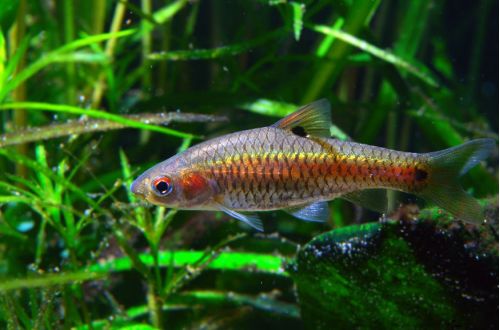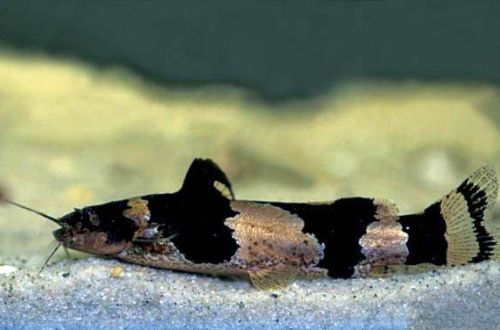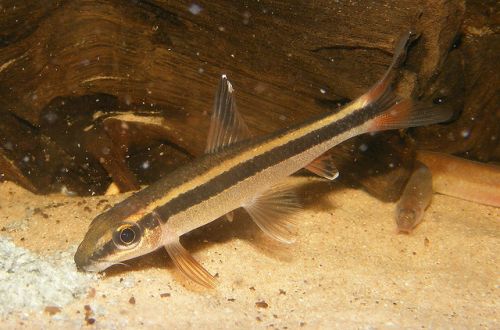
Two-spotted Barbus
The two-spotted barb, scientific name Puntius bimaculatus, belongs to the Cyprinidae family. A flock of these fish will look great in almost any aquarium, they are unpretentious, easy to keep and breed, compatible with many popular species. Suitable for beginner aquarists.

Contents
Habitat
The region of origin is limited to the southern tip of India and the island of Sri Lanka. They live in numerous small and medium-sized rivers flowing from hills and mountainous areas under the canopy of tropical forests, stay mainly in places with a more or less calm course, absent on the plains.
In Sri Lanka, it lives in mountain streams at an altitude of more than 1500 meters above sea level, which is extremely rare among freshwater fish species.
Currently, wild populations have been significantly reduced due to human activities – water pollution and deforestation. The mass catch of these fish for the aquarium trade by local residents also made a negative contribution.
Description
Miniature fish, adults rarely exceed 5 cm in length. In appearance, males look more elegant and slimmer than females, the latter are more overweight, especially during the spawning period. There is a red horizontal stripe in the coloration, the intensity of which varies greatly from individual to individual. In some it is clearly visible, in others it is barely distinguishable. A characteristic element of the body pattern in this species, which is also reflected in the Latin name, is the presence of two dark dots. The first is located in the middle at the base of the dorsal fin, the second on the caudal peduncle.
Food
They prefer a varied diet, including protein and vegetable components. At home, you can feed with high-quality dry or freeze-dried food (flakes, granules). An excellent addition will be live or frozen food from daphnia, bloodworms, small aquatic insects and other zooplankton. Feed 2-3 times a day in the amount eaten in 5 minutes, the remains of food should be removed.
Maintenance and care, arrangement of the aquarium
A flock of Point-to-Point Barbs will require a modest tank of 60 liters or more, designed with plenty of vegetation. Dense plantings in a sandy or rocky substrate, coupled with some roots, snags and other shelters, will create optimal conditions for these modest creatures. Floating plants will also come into place and additionally scatter light.
Water conditions have slightly acidic pH values closer to neutral, water hardness should be low to medium. Read more about pH and dGH parameters and how to change them in the “Hydrochemical composition of water” section.
The recommended minimum set of equipment consists of a filtration system, a heater, an aerator and lighting fixtures, the latter are set to low power, the fish do not welcome bright light.
Aquarium maintenance comes down to a weekly replacement of part of the water with fresh water (20–30% of the volume) and periodic cleaning of the soil from organic waste.
Behavior and Compatibility
A very peaceful and friendly schooling fish, due to its meek disposition and unpretentiousness to water hydrochemistry, Barb Two-point is compatible with most popular peaceful species of similar size from among other cyprinids, as well as viviparous, characin, etc.
It is recommended to keep at least 6-10 individuals in a group; this will make the fish not only less shy, but also contributes to the manifestation of a brighter color, which is especially characteristic of males.
Breeding / breeding
Under favorable conditions, the mating season occurs several times a year, the creation of special conditions is not required, the fish successfully bring offspring in the general aquarium. However, due to the underdevelopment of parental instincts and the tendency to eat their own fry, it is recommended to spawn in a separate tank.
The spawning aquarium usually has 15-20 liters of volume. The design uses soil made of large pebbles (balls) or ordinary sandy, but covered on top with a finely meshed mesh. The eggs, rolling in the cavity between the pebbles or under the net, become inaccessible to the parents. Plants are allowed, but look for low-growing species with small leaves that form dense clumps, such as Java moss. Such plants act as an additional shelter for eggs. The set of equipment consists of a simple foam filter and a heater. Lighting should be dim, so the amount of light from the room will be enough, a separate lamp is not required. It is filled with water from the main aquarium.
The stimulus for the beginning of the mating season is an increase in water temperature to the upper permissible limit (23–24°C) and the transition to predominantly protein food (live or frozen). After a while, the females become noticeably rounder, this serves as a signal to place them in a separate tank, where a male / males are also added every other day.
At the end of spawning, the fish return back. The fry appear after 1-2 days, after the next 24 hours they begin to swim in search of food. Feed microscopic food, either special from the pet store or live, such as brine shrimp nauplii, microworms, ciliates, etc.





